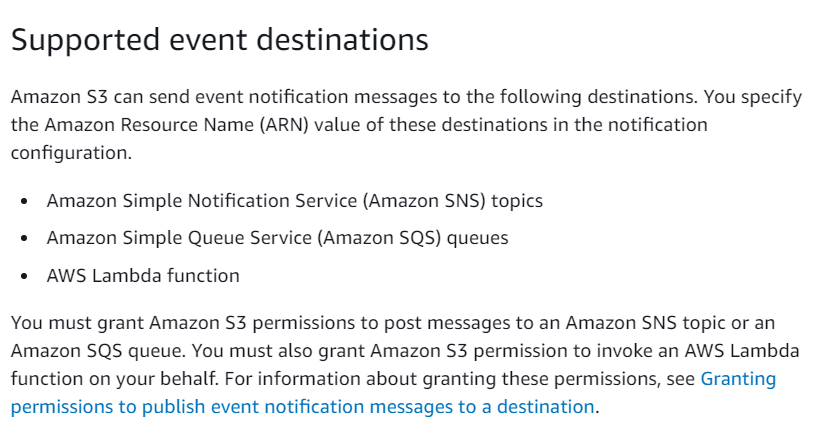Notify Non-IAM Users After Uploading Large Files to AWS S3 Bucket
Question
You are uploading multiple files ranging 10 GB - 20 GB in size to the AWS S3 bucket by using a multi-part upload from an application on EC2
Once the upload is complete, you would like to notify a group of people who do not have AWS IAM accounts.
How can you achieve this? (Select TWO)
Answers
Explanations
Click on the arrows to vote for the correct answer
A. B. C. D.Answer: A and B.
The Amazon S3 notification feature enables you to receive notifications when certain events happen in your bucket.
To enable notifications, you must first add a notification configuration identifying the events you want Amazon S3 to publish and the destinations where you want Amazon S3 to send the event notifications.
AWS Simple Email Service (SES) is a cost-effective email service built on the reliable and scalable infrastructure that Amazon.com developed to serve its own customer base.
With Amazon SES, you can send transactional emails, marketing messages, or any other type of high-quality content.
While your account is in the sandbox, you can use all of the features of Amazon SES.
However, when your account is in the sandbox, we apply the following restrictions to your account:
You can only send mail to verified email addresses and domains or to the Amazon SES mailbox simulator.
You can only send mail from verified email addresses and domains.
https://docs.aws.amazon.com/ses/latest/DeveloperGuide/request-production-access.htmlOption A triggers Lambda function which uses non-sandbox SES to send email to people who does not have an AWS IAM account nor are verified in AWS SES.
https://aws.amazon.com/premiumsupport/knowledge-center/lambda-send-email-ses/Option B is correct as it triggers SNS.
https://docs.aws.amazon.com/AmazonS3/latest/dev/ways-to-add-notification-config-to-bucket.htmlOptions C and D are incorrect because they needs compute resources to monitor S3 for new files continuously.
References:
https://docs.aws.amazon.com/AmazonS3/latest/userguide/notification-how-to-event-types-and-destinations.html#supported-notification-event-types https://docs.aws.amazon.com/AmazonS3/latest/userguide/NotificationHowTo.html
Sure, I can help you with that.
The scenario described in the question involves uploading large files to an S3 bucket using a multi-part upload from an EC2 instance. After the upload is complete, you need to notify a group of people who do not have AWS IAM accounts.
To achieve this, there are two options available:
- Use S3 event notification and configure a Lambda function which sends email using AWS SES non-sandbox.
- Use S3 event notification and configure SNS which sends email to subscribed email addresses.
Let's discuss both options in detail:
Option 1: Use S3 event notification and configure a Lambda function which sends email using AWS SES non-sandbox.
This option involves using S3 event notification to trigger a Lambda function that sends an email using AWS SES (Simple Email Service) non-sandbox.
Here's how it works:
Step 1: Create an S3 bucket and enable event notification.
Step 2: Create a Lambda function that sends an email using AWS SES non-sandbox.
Step 3: Configure the Lambda function as a target for S3 event notification.
Step 4: Upload the files to the S3 bucket using multi-part upload. Once the upload is complete, S3 will trigger the Lambda function which will send an email to the specified recipients.
Option 2: Use S3 event notification and configure SNS which sends email to subscribed email addresses.
This option involves using S3 event notification to trigger an SNS (Simple Notification Service) topic that sends an email to subscribed email addresses.
Here's how it works:
Step 1: Create an S3 bucket and enable event notification.
Step 2: Create an SNS topic and subscribe email addresses to it.
Step 3: Configure the SNS topic as a target for S3 event notification.
Step 4: Upload the files to the S3 bucket using multi-part upload. Once the upload is complete, S3 will trigger the SNS topic which will send an email to the subscribed email addresses.
Now, let's discuss why the other two options are not valid:
Option C: Write a custom script on your application side to poll S3 bucket for new files and send email through SES non-sandbox.
This option involves writing a custom script on your application side to poll the S3 bucket for new files and send an email using AWS SES non-sandbox. While this option is technically feasible, it is not the best approach as it requires you to manage the script and the associated infrastructure.
Option D: Write a custom script on your application side to poll S3 bucket for new files and send email through SES sandbox.
This option is not valid because AWS SES sandbox only allows you to send emails to verified email addresses or domains. Since the recipients in this scenario do not have AWS IAM accounts, it is likely that their email addresses are not verified, making this option impractical.
I hope this helps! Let me know if you have any more questions.